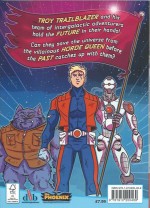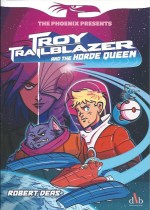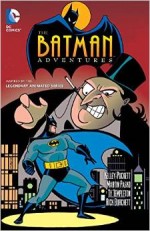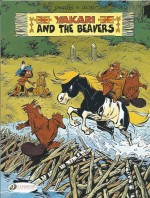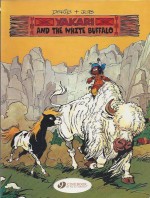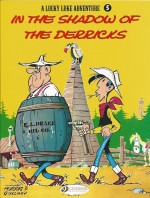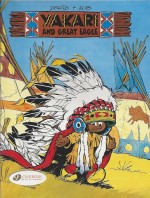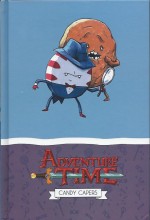
By Ananth Panagariya, Yuko Ota, Ian McGinty, Evan Dahm, Tessa Stone, Maarta Laiho & various (Titan Comics)
ISBN: 978-1- 78276-318-5
If you haven’t seen the Cartoon network show this book spins off from, Adventure Time is set in a post-apocalyptic future about a thousand years after the “Great Mushroom Warâ€. In the oddly magical Land of Ooo a bizarre coterie of largely comestible and confectionery-based life-forms live their strange lives and a human boy and his shapeshifting dog are having a grand old time…
Scripted by Ananth Panagariya and Yuko Ota, primarily illustrated by Ian McGinty and vividly coloured by Maarta Laiho, the Kaboom!/Boom! Studios 6-issue miniseries Adventure Time: Candy Capers has been repackaged as a stunning and sturdily oversized (193 x 287 mm) full-colour hardback which begins by revealing how heroic Jake and Finn are at last recognised as being missing in ‘Sour Problems in Sweet Town’ when regal Princess Bubblegum suddenly remembers she gave them the hammer she really, really needs right now!
Her decision is to assign her creepy major domo Peppermint Butler to the case but his scary scouring of the kingdom doesn’t go well because his un-trusty associate ‘Cinnamon Bun is Helping! (to the despair of those around him)’…
Since it’s not a proper kingdom without heroes Jake and Finn, the Princess promotes the Butler to being-in-charge-of-protecting-everything and goes off to look for them herself…
The new Boss of the Banana Guards is not so good at “Destroying Problems†however and soon decides that the best way forward is to reinstate the ‘Royal Hero Draft’…
Peppermint’s first picks are snarky Marceline the Vampire Queen and elephantine Treetrunks, whom he promptly despatches to weirdly accursed Bloodskull Village to solve the ‘Mystery, She Wrote’.
Using their dubious wiles and the mantra “what would Jake and Finn do?†the bizarre babes soon unearth the Bad Haircut Wizard who claims to be behind the town’s woes… Oh, and they also discover Finn’s Demon Blood Sword is being used as a utensil at the local diner…
When Marceline and Treetrunk both suddenly retire, Peppermint Butler and Cinnamon Bun decide to check out whether the missing heroes are no longer alive and pop down to the Land of the Dead to ask the guy in charge. However to get in they first have to waste time playing the ‘Game of Death’ (art by Evan Dahm) with his moronic minions…
Finally finding that the AWOL champions aren’t dead, PB and CB are forced to carry on looking for them and so reluctantly draft the obnoxiously inept Earl of Lemongrab and gabby Lumpy Space Princess to go quiz the Why-Wolves.
The scary canines are intrigued but in return want all the other wolves to stop calling them nerds when they meet at ‘The Summit of Wolf Mountain’.
Sadly, the ‘Gathering of Wolves’ goes badly but just when the assembled clans are about to eat each other and everybody else, Lemongrab accidentally breaks an ancient curse and something truly extraordinary happens…
Forced to fire his latest draftees, Peppermint Butler again petulantly takes up the case and starts looking for who sold Finn’s Demon Blood Sword to the cursed café. The trail leads to arms dealer Choose Goose but the rhyming rowdy wants something in return for his information and expects the detectives to become his suave spies in the ‘Casino Royal’…
Bad Guy Magpie is a very competent opponent who nevertheless mistakes the dapper minty delicacy for superspy Agent Princess but when the real her comes to the rescue the entire cheating clip joint goes up in flames…
Next to be suckered into the hero-game are Jake and Finn’s old enemies Ice King and Susan Strong, who are called upon to stop a giant from crushing a distant hamlet. Somehow the incompetent idiots uncover an actual plot to frame the big guys but typically, to save the village they have to destroy the village…
Fed up with defending the Realm Peppermint B reveals his own dark wizardly gifts in ‘Reflections and Dark Confections’ before employing those eldritch arts to seek out the lost lads. That doesn’t go too well and soon he and Cinnamon are battling demonic doppelgangers and confronting a kleptomaniac cross-dressing Sea Witch they believe might have kidnapped Jake and Finn. Sadly however, the trail turned out to be a simple red herring…
Princess Bubblegum takes charge again for a raid on the ‘Lair of the Vault King’ (illustrated by Tessa Stone) but Peppermint Butler’s superteam of the Bun, Starchy, Hot Dog Princess, BMO, Neptr, Agent Princess, Gunter, Mr. Cupcake, Muscle Princess, Notorious Pup Crew and the rest are not willing enough or ready for ‘Operation: Cinnamon Bun’s Cool Plan!’ and the sugary sortie goes awry after they all realise that Jake and Finn were never there in the first place…
The interminable mystery is finally resolved in ‘Sunset on Candy Kingdom’ when the badgered butler loses patience and determines to use his magic to make the heroes Ooo desperately needs. Sadly when his gooey golems set of to “Destroy Problems†even his last-minute conversion to costumed crusading is insufficient to end the rampage and it takes the blockbusting Bubblegum Princess to save the day…
And only then does she remember where she put Jake and Finn…
Augmenting this sublimely surreal romp is a huge ‘Cover Gallery’ – 35 stunningly sweet and sickly weird images by Josceline Fenton, Magnolia Porter, Rebecca Mock, Tessa Stone, Yuko Ota, Tyler Parker, Bryan Turner, Maris Wicks, Nomi Kane, Brinson Thieme, Jemma Salume, Scott Maynard, T. Fabert, Melanie Gillman Brooke Allen, Andrea Tamme, Jay Fosgitt, Fellipe Martins, Yasmin Liang, Eva Eskelinen, Michael Dialynas, Mia Schwartz, Laura Birdsall, Andy Price, Mychal Amann, Mad Rupert, Renato Faccini, Wook Jin Clark, Emily Watson, Andy Hirsch and Hannah Nance Partlow – as well as ‘Cold Case Files’ which reveal ‘Cover Inspirations’ providing the original half dozen pop culture detectives who informed Yuko Ota’s covers.
Rounding out the cartoon confections are a cornucopia of ‘Character Designs’ and ‘Layout Designs’ for those inspired to concoct a few graphic Adventures Times of their own…
Strangely addictive, madly absurd and sweet as cartoon candy, this is a treat for young and old alike.
© Cartoon Network (S15). All rights reserved.

